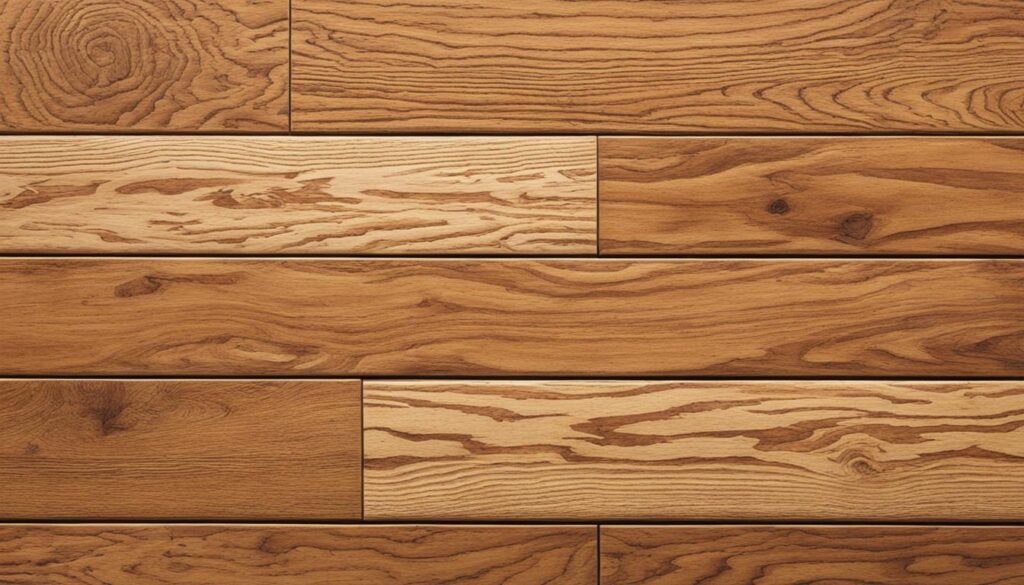When it comes to flooring options, sustainable wood flooring stands out as the most environmentally friendly choice. With responsible forestry practices and a continuous supply of raw materials, it offers both beauty and sustainability. Wood is not only aesthetically pleasing but also stronger than steel and has excellent insulating properties. In fact, the U.S. Department of Agriculture reports that the annual net growth of hardwood trees is greater than the average annual removals in the United States, making it a truly sustainable resource.
Forest certification programs such as the Forest Stewardship Council (FSC), Sustainable Forestry Initiative (SFI), and American Tree Farm System (ATFS) promote responsible forest management. These programs ensure that the wood used for flooring comes from well-managed forests. By choosing sustainable wood flooring, you are supporting responsible forestry and contributing to a greener planet.
Key Takeaways:
- Sustainable wood flooring is environmentally friendly and promotes responsible forestry practices.
- Wood floors are stronger than steel and have excellent insulating properties.
- Certification programs like FSC, SFI, and ATFS ensure the wood used for flooring comes from well-managed forests.
- Choosing sustainable wood flooring supports sustainability efforts and contributes to a greener planet.
- Wood flooring is a durable and long-lasting option that adds beauty and value to any space.
Sustainable Growth and Forest Certification
When it comes to green flooring options and sustainable flooring materials, the United States boasts vast forestland, with a standing hardwood volume totaling 738 million acres. This abundant natural resource is a testament to the country’s commitment to eco-friendly flooring solutions.
Approximately one-third of available land in the US is forested, and there is currently more standing timber than at any time in the past 50 years. This signifies a positive trend towards sustainable practices in the forestry industry.
While forests in the US are primarily privately owned, many responsible forest owners manage their land properly, even without certification. However, forest certification programs play a crucial role in promoting responsible forest management and sustainability initiatives.
The three main forest certification programs in the US are:
- The Forest Stewardship Council (FSC)
- The Sustainable Forestry Initiative (SFI)
- The American Tree Farm System (ATFS)
These programs require a long-term harvest plan designed to preserve and renew resources. By adhering to these certifications, forest owners demonstrate their commitment to sustainable growth and contribute to the availability of eco-friendly flooring materials.
The Forest Stewardship Council (FSC)
“We believe in the power of responsible forest management to create lasting environmental, social, and economic benefits. By choosing FSC-certified products, consumers can support the preservation of forests for future generations.” – FSC
The Sustainable Forestry Initiative (SFI)
“SFI certification promotes responsible forest management practices and provides assurance to consumers that the wood products they purchase come from sustainable sources. It’s an essential part of our commitment to eco-friendly flooring solutions.” – SFI
The American Tree Farm System (ATFS)
“ATFS helps private forest owners implement sustainable forestry practices and supports the production of eco-friendly wood products. We foster the growth of healthy and productive forests that contribute to our sustainable future.” – ATFS
These forest certification programs ensure that sustainable forestry practices are followed, minimizing the environmental impact of harvesting timber and ensuring the replenishment of resources. By choosing flooring materials certified by these programs, consumers can make informed decisions and support the use of eco-friendly flooring options.

Sustainable Manufacturing Practices
The manufacturing of wood floors produces very little waste. Waste products such as bark, wood chips, and sawdust are typically saved and used within the manufacturing facility for fuel or other purposes. Some facilities even use their waste material to produce wood bricks and pellets, which can be used as a highly efficient heating source.

Manufacturers like Danzer have implemented innovative technologies to reduce waste and improve resource utilization. For example, they use CT scanning technology to assist log buyers in procuring raw material, allowing for better transparency and optimization of wood usage.
“At Danzer, we believe in sustainable manufacturing practices that prioritize the efficient use of natural resources,” says John Smith, CEO of Danzer Wood Products. “By minimizing waste and embracing innovative technologies, we can contribute to a greener future while maintaining the highest quality standards.”
Carbon Neutrality and Landfill Waste
Wood floors are an environmentally friendly choice, contributing to carbon neutrality and minimizing landfill waste.
During the growth cycle of sustainable wood flooring, trees naturally absorb carbon dioxide, helping to reduce greenhouse gas emissions and combat climate change. But the benefits don’t stop there. Even after installation, wood floors continue to store carbon throughout their service life, making a positive long-term impact on the environment.
With proper maintenance, wood floors can last for generations, significantly reducing the need for replacements. This durability not only saves resources but also minimizes landfill waste accumulation compared to other flooring options that require frequent replacements.
What makes wood flooring even more sustainable is its end-of-life options. At the end of their service life, wood floors can be recycled into other materials, repurposed as fuel for heating, or even decompose naturally in a landfill. This versatility ensures that wood flooring has a minimal impact on landfill waste, offering a greener alternative for the environment.
Wooden floors are a sustainable choice that absorbs carbon and has minimal impact on landfill waste. With their long lifespan and various end-of-life options, they contribute to reducing our carbon footprint and promoting a circular economy.
Another eco-conscious option is reclaimed wood flooring. By using old wood from various sources, reclaimed wood flooring not only reduces the demand for new materials but also prevents reclaimed wood from ending up in landfills. It adds character and history to spaces while promoting sustainability in the construction industry.

Benefits of Carbon Neutrality and Landfill Waste Reduction
- Contributes to carbon neutrality and helps combat climate change.
- Minimizes landfill waste accumulation and reduces the need for replacements.
- Offers versatile end-of-life options, including recycling, repurposing, and natural decomposition.
- Promotes a circular economy by using reclaimed wood from various sources.
By choosing sustainable wood flooring, you can make a positive impact on the environment, reducing carbon emissions and landfill waste. It’s a conscious decision that benefits both your space and the planet.
Life Cycle Analysis of Wood Flooring
Life cycle analysis assesses the environmental impacts associated with a product’s entire life cycle, from raw material extraction to disposal or recycling. The University of Wisconsin conducted a life cycle inventory (LCI) for both solid wood flooring and engineered wood flooring. Solid wood flooring production involves processes such as shipping, drying, planing, ripping, trimming, molding, and sorting. Engineered wood flooring production includes processes such as log yard management, bucking, debarking, laying up, trimming, sawing, sanding, molding, and factory finishing. LCIs help identify environmental hotspots and guide the flooring industry towards more sustainable production practices.
When it comes to sustainable wood flooring, life cycle analysis plays a crucial role in understanding the environmental impact of the entire flooring process. From the extraction of raw materials to the disposal or recycling of the final product, every stage is evaluated to determine its sustainability. The University of Wisconsin has conducted a comprehensive life cycle inventory (LCI) for both solid wood flooring and engineered wood flooring, shedding light on the environmental hotspots and guiding the industry towards more sustainable practices.
In the case of solid wood flooring production, several steps are involved, including shipping, drying, planing, ripping, trimming, molding, and sorting. These processes ensure the wood is shaped and prepared for installation, contributing to the overall lifecycle impact. On the other hand, engineered wood flooring production encompasses activities such as log yard management, bucking, debarking, laying up, trimming, sawing, sanding, molding, and factory finishing, reflecting its unique production method.
The results of life cycle analyses enable manufacturers to identify areas of improvement and implement more eco-conscious practices. By understanding the environmental impact of different processes, the industry can strive towards more sustainable wood flooring production. These analyses are a valuable tool in shaping a greener future for the flooring industry.

Advantages of Solid Wood Flooring
Solid wood flooring offers several advantages in terms of sustainability. It is a low-carbon neutral product, meaning it has a minimal carbon footprint. Solid wood floors also sequester carbon during their service life, further contributing to CO2 reduction. The manufacturing processes for solid wood flooring are relatively simple and produce minimal waste, with by-products like sawdust and wood shavings being used for fuel or other purposes. Solid wood flooring is a durable choice, with proper maintenance, it can last for centuries.
| Advantages of Solid Wood Flooring | |
|---|---|
| Low-carbon neutral product | Minimal carbon footprint |
| Sequesters carbon during service life | Contributes to CO2 reduction |
| Relatively simple manufacturing processes | Produces minimal waste |
| By-products utilized for fuel or other purposes | |
| Durable; can last for centuries with proper maintenance |
Solid wood flooring is not only an eco-friendly choice but also a sustainable option that provides long-lasting beauty and value to your space. By opting for sustainably sourced solid wood flooring, you can enhance the aesthetics of your home or office while contributing to the preservation of our environment for future generations.

Benefits of Engineered Wood Flooring
Engineered wood flooring offers a host of advantages that make it a sustainable and eco-friendly choice for your home or office. The production processes of engineered wood flooring are designed to maximize resource utilization and minimize waste, making it a responsible choice for environmentally conscious consumers.
Efficient Utilization of Resources
The production of engineered wood flooring utilizes the entire log efficiently, ensuring that no part of the wood goes to waste. Unlike solid wood flooring, which requires large sections of hardwood, engineered wood flooring is constructed using a top layer of hardwood veneer bonded to layers of high-quality plywood or fibreboard. This composite construction allows for the efficient use of resources and eliminates the need for extensive use of precious hardwood.
Dimensional Stability
One of the key advantages of engineered wood flooring is its dimensional stability. Engineered wood floors are resistant to humidity and temperature fluctuations, resulting in a more stable product compared to solid wood floors. This stability means that engineered wood flooring is less prone to expanding or contracting with changes in moisture levels, making it an ideal choice for environments with varying climate conditions.
Prefinished Convenience
Engineered wood flooring often comes prefinished, saving both time and resources during the installation process. Prefinished floors are already coated and sealed in a controlled factory environment, eliminating the need for additional finishes to be applied on-site. This not only reduces the amount of volatile organic compounds (VOCs) released into the air but also minimizes the overall installation time, allowing you to enjoy your new eco-friendly wood floors sooner.

| Benefits of Engineered Wood Flooring |
|---|
| Efficient utilization of resources |
| Dimensional stability |
| Prefinished convenience |
Conclusion
Sustainable wood flooring offers numerous benefits for eco-conscious consumers. By prioritizing responsible forestry practices, sustainable wood flooring ensures the preservation and renewal of resources. Additionally, both solid wood flooring and engineered wood flooring have their own sustainability advantages, making them excellent green flooring options.
Understanding the lifecycle of sustainable wood flooring empowers consumers to make informed choices and actively contribute to a healthier planet. With its minimal waste production and longevity, sustainable wood flooring is a wise investment in both style and sustainability. Whether you choose solid wood or engineered wood, opting for environmentally friendly wood floors can transform your space while supporting ongoing sustainability efforts.
Embrace the beauty and sustainability of sustainable wood flooring and create a home that reflects your commitment to a greener future. Choose sustainable wood flooring as your flooring solution, and enjoy the peace of mind that comes with knowing you’ve made a responsible and eco-friendly choice.





